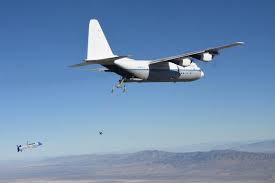In the sky above the desert, a drone mated with a C-130, a cargo plane that was acting as an airborne aircraft carrier. Once its landing hook attached to the C-130’s recovery latch, the drone’s wing rotated 90 degrees, becoming flush with its body, so that it could fit within the cargo plane’s storage bay. Pulled into the crane-like gripper of the C-130’s retrieval arm, the drone lands in its ride in the sky.
On November 5, DARPA announced that Gremlins, its long-in-the-works program to make an air-launched and air-recoverable drone, successfully demonstrated airborne recovery. The flight test, which took place in October, featured two Gremlin drones flying a series of checks. One of those Gremlins latched onto and was loaded inside the C-130. The other, as Defense News reports, crashed during the tests.
“Airborne recovery is complex,” Paul Calhoun, DARPA’s program manager for Gremlins, said in a release. “We will take some time to enjoy the success of this deployment, then get back to work further analyzing the data and determining next steps for the Gremlins technology.”
The Gremlins program dates back to at least 2015, though the concept of aircraft launched and recovered from other aircraft has a much longer history. The utility is straightforward: small vehicles have less capacity for fuel, weapons, or other payloads, so it makes sense to deliver them inside a bigger, more efficient craft, which can then pick them up again. Meanwhile, C-130s, the venerable workhorses of military cargo transport, are an ideal carrier craft. Reliable, durable, and spacious, a C-130 is good at getting where it needs to go.
As a lumbering cargo aircraft, C-130s are big targets for anti-aircraft weapons, but if the drones that they are launching into combat can fly the last leg of the journey on its own, the C-130 can stay safely out of range of an adversary’s weapons.
In the 1930s, the US Navy experimented with airships that could launch and recover biplanes from racks inside the craft. That recovery element is essential, especially for aircraft with a pilot on board, because it makes it a mission that pilots can fly away from. In the Cold War, the Air Force developed the trapeze-launched Goblin, an ultracompact jet fighter that could ride inside the bomb bay of a nuclear-armed bomber to protect it from other fighter jets.
Gremlins is not an exact continuation of prior aircraft-launched aircraft, though it shares some important principles. Being able to launch and recover from a rack inside the carrier means the drone doesn’t need to operate from a runway. With its fold-under wing and compact form, four Gremlins can fit in the pay of a C-130.
Being able to field four drones at once from a single C-130 would let the plane scout a wide area, or potentially launch attacks on several targets. Scouting is the most straightforward mission for a Gremlin, but it could also carry tools for electronic warfare, like jammers that mess up with sensors, and it’s possible future drones could be armed with bombs and other conventional weapons.
Source : https://www.popsci.com/technology/darpa-gremlins-recovers-flying-drone/









